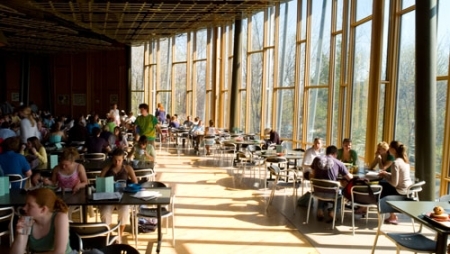You have /5 articles left.
Sign up for a free account or log in.

A dining hall at Middlebury
Middlebury College
Middlebury College is weakening a plan to hold down student costs.
The Vermont-based liberal arts college announced in 2010 it would cap its tuition, room and board charges at 1 percentage point above the rate of inflation. The strategy, its president said at the time, was designed to recognize there was a price at which even the richest families would question their investment in a four-year liberal arts degree. The college has attracted considerable praise for its policy.
Now, the same administration is breaking its own self-imposed limits, at least for the coming academic year. The college’s Board of Trustees increased the sticker price for students by 1.44 percent above the rate of inflation – which means students will pay about $250 more next year than they would have if Middlebury had kept the cap in place.
A college spokesman blamed rising room and board costs, such as that of providing vegan and gluten-free dining options.
“That kind of demand certainly tends to drive up cost,” said Middlebury spokesman Bill Burger. He said the college was “fine-tuning” its strategy – which was known as CPI+1, for Consumer Price Index plus 1 percent. He said the plan was never a “formal policy” meant to last forever.
While the college has been working to diversify its revenue sources, including a new language school in Korea, in the three fiscal years since Middlebury announced the caps, general operating expenses have risen at twice the rate of revenue from student fees, according to audited financial statements for the college. Last week, Moody’s Investors Service affirmed the college’s credit rating but noted operating deficits in the past two fiscal years of 2.4 and 4.3 percent.
“We certainly, as many institutions did, cut costs in a fairly severe way in the economic crisis and we have had to restore some level of services we had reduced, so there has been an increase,” Burger said.
Middlebury is quick to point out that the CPI+1 policy has brought Middlebury’s costs down relative to its peers -- 21 private liberal arts colleges, most of them in the Northeast. When Middlebury announced the CPI+1 strategy in 2010, it had among the highest sticker prices of its peers, according to its own data. Now it has among the lowest. Its price increases last year were also among the lowest. The least expensive among those peers, Mount Holyoke, froze tuition for two years, but is planning a 2.9 percent increase this year.
|
Institution
|
2009-10 tuition, room, board and fees before Middlebury's CPI+1 policy
|
2014-15 tuition, room, board and fees
|
| Amherst College | $50,290 | $61,206 |
| Hamilton College | $49,860 | $59,970 |
| Middlebury College | $50,780 | $59,160 |
But Laura W. Perna, a professor of education at the University of Pennsylvania who has written extensively on college affordability issues, said even Middlebury’s inflation benchmark may increase prices too much. She said because general inflation has been rising faster than average family income, even an attempt to hold costs by tying increases to inflation would still widen the gaps between what families can afford and what colleges charge.
"There are a lot of different levers that go into influencing and determining if college is affordable to students,” Perna said.
In the 18 years before it announced the CPI+1 plan, Middlebury’s price had risen an average of 2.36 percentage points above inflation.
Middlebury’s at least tentative shift away from the CPI+1 plan, which the board decided on in February, is partially obscured by the language the college is using to described this year’s prices.
In 2010, when he announced the CPI+1 plan, Middlebury President Ronald D. Liebowitz, said he wanted the CPI+1 cap to apply to the college’s "comprehensive fee" -- the equivalent of tuition, room and board.
This year, Middlebury is now seeking to distinguish room and board from tuition. Tuition prices are still following the CPI+1 plan and went up 2.5 percent – which is 1 percentage point above last year’s 1.5 percent inflation rate. But room and board fees, which make up about a quarter of student fees, were increased by 4.5 percent. The overall increase was 2.94 percent for a total sticker price for tuition, room and board of $58,753 compared to last year’s $57,075. Middlebury also charges a $407 mandatory fee, which increased $12.
“What you see here does represent a change," Burger said. "This year we have explicitly broken out the tuition and the room and board charges and we have applied the CPI+1 formula to tuition, which is by a significant amount the largest component of the fees that students pay. But in recognition of the increased costs we face around room and board, we choose this year to increase that fee by a slightly larger amount.”
Middlebury was among only a handful of colleges that had not been separating room and board fees from tuition, said Sandy Baum, a research professor of education policy at George Washington University and a senior fellow at the Urban Institute. She said it's fine for the college to go back on its strategy, but it should do a better job explaining the pros and cons of what it did.
“To break it out and then say, 'We are maintaining the policy,' but actually not maintaining the policy -- that is misleading and I think that’s unfortunate," Baum said.
She said Middlebury's move reminded her of the year Princeton University froze tuition but increased room and board fees. Baum said Middlebury's problem is that it made dramatic statements about plans that probably were not realistic.
Burger said the college is separating room and board from tuition because “we just think that provides better transparency into the components of the fees that students pay.”
He wouldn’t speculate about whether the college will try to follow the CPI +1 plan in the future for tuition or for room or board but said the college's board would "continue to be mindful of the cost of attending Middlebury."
Middlebury is not the only prestigious liberal arts college to back away from an innovative attempt to cut prices. Two years after the University of the South -- also known as Sewanee -- announced a dramatic 10 percent price cut, charges there are back up to nearly what they had been.




